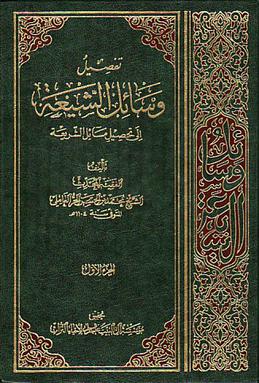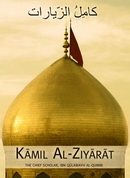
Abu 'Abd Allah Muhammad ibn Muhammad ibn al-Nu'man al-'Ukbari al-Baghdadi, known as al-Shaykh al-Mufid and Ibn al-Mu'allim, was a prominent Iraqi Twelver Shia theologian. His father was a teacher (mu'allim), hence the name Ibn al-Mu'allim. The title "al-Mufid" was given to him either by Muhammad al-Mahdi, the twelfth Shia Imam, or by al-Rummani, a Sunni scholar, after a conversation with him. The leader of the Shia community, he was a mutakallim, theologian, and Shia jurist.

Man lā Yaḥḍuruhu al-Faqīh is a Hadith collection by the famous Twelver Shia Hadith scholar Abu Jaʿfar Muḥammad ibn ʿAli ibn Babawayh al-Qummi, commonly known as Ibn Babawayh or Sheikh al-Saduq. This work is included among the Four Books of Twelver Shia Islam.
Shaykh Tusi, full name Abu Ja'far Muhammad ibn al-Hasan al-Tusi, known as Shaykh al-Ta'ifah was a prominent Persian scholar of the Twelver school of Shia Islam. He was known as the "sheikh of the sect ", author of two of the four main Shi'i books of hadith, Tahdhib al-Ahkam and al-Istibsar, and is believed to have founded the hawza. He is also one of the pioneering scholars of Shiite ʾUṣūl al-Fiqh and considered "a cardinal founder of ijtihad".

Abu Ja'far Muhammad ibn 'Ali ibn Babawayh al-Qummi, commonly referred to as Ibn Babawayh or al-Shaykh al-Saduq, was a Persian Shia Islamic scholar whose work, entitled Man La Yahduruhu al-Faqih, forms part of The Four Books of the Shia Hadith collection.

Wasa'il al-Shia is a reputable book of hadith in Shia Islam, compiled in the 17th century by Shaykh al-Hurr al-Amili. Shaykh Al-Hurr wrote two editions of this book, Ahl al-Bayt which is a 30 volume long edition of it, and Al-Islamiyyah which is 20 volumes long.
Thābit ibn Abī Ṣafiyya famously known as Abū Ḥamza al-Thumālī Thābit ibn Dīnār formerly disciple of Ali al-Sajjad, was also among Muhammad al-Baqir's followers. He is regarded as a trustworthy transmitter of hadith, especially those about miracles.

Tahdhib al-Ahkam is the third hadith collection of the Four Books of Shia Islam. It was compiled by Twelver Shia Hadith scholar al-Tusi. This work is included among the four books of Shia Islam. It is a commentary on the al-Muqni'a by Al-Shaykh Al-Mufid, who was a Twelver Shia theologian.
Abū al-Qāsim ʿAlī ibn al-Ḥusayn al-Sharīf al-Murtaḍā, commonly known as Sharīf Murtaḍā or Sayyid Murtaḍā and also popular as ʿAlam al-Hudā, was an Iraqi scholar and considered one of the greatest Shia scholars of his time. He was one of the students of Shaykh al-Mufīd. His younger brother is al-Sharif al-Radi, the compiler of Nahj al-Balagha. He was four years older than his brother. He lived during the era of Buyid dynasty. It was the golden age of Arabic literature, and great poets Al-Ma'arri were among his contemporaries.
Badā' البَدَاء is a Twelver Shia Islamic concept regarding the Will of God. It refers to God revealing his will about a decision, wherein the people thought his will had already been made on that issue, as the Shia believe that God has knowledge of the ultimate outcome.
Uyoun Akhbar Al-Ridha, counted as a Hadith book among Shia, the book was written by Ibn Babawayh, one of the great scholars of Shia Muslims. The book concerned with saying and life of the eighth Shia Imam Ali al-Ridha.
Taḳī al-Dīn Abū ’l-Fatḥ Muḥammad b. ʿAlī b. Wahb b. Muṭīʿ b. Abi ’l-Ṭāʿa, commonly known as Ibn Daqiq al-'Id, was a Sunni Egyptian scholar. He is widely accounted as one of Islam's great scholars in the fundamentals of Islamic law and belief, and was the leading authority in the Shafi'i legal school. He was a prominent jurist with several major works of law to his credit. He was also equally proficient in hadith. He was a highly acclaimed muhaddith and a prolific writer on hadith and ilm al-rijal. He was known as the leading traditionist in his time and it is professed he was "the most respected scholar of hadith in the thirteenth century." Although Ibn Daqiq al-'Id mastered Shafi'i jurisprudence under Ibn 'Abd al-Salam, he was also well-versed in Maliki fiqh. He served as chief judge of the Shafi'i school in Egypt. He was regarded as a highly esteemed and pious judge in his own day. He excelled in numerous Islamic sciences and was an authority in Arabic language and scholastic theology. He was also noted for his great skills in poetry, oratory, and literature. According to Taqi al-Din al-Subki, there was an consensus among Muslims that Ibn Daqiq al-'Id "was a mujtahid mutlaq with complete knowledge of legal sciences" as well as the mujaddid in the 8th Islamic century.
Al-Nihāyah is one of the greatest juridical books among Shia. This book contains many narratives and juridical rulings.The author of al-Nihayah is Shaykh Tusi, a prominent historical Shi'i jurist.
Ibn Qūlawayh was a Twelver Shia traditionalist and jurist. He is one of the authoritative traditionalists among the Shia.

Kamil al-Ziyarat is a Hadith collection of 843 traditions, by the famous Twelver Shia Hadith scholar Abu al-Qasim Ja'far b. Muhammad b. Ja'far b. Musa b. Qulawayh a-Qummi al-Bahdadi, commonly known as Ibn Qulawayh.
Ja'fari principles refers to regulations, history and eminent persons and scholars during the development of Shia's Principles of Islamic jurisprudence.
Uddat al-Usul is a book on principles of jurisprudence, written by Shaykh Tusi. Shaykh Tusi knows the book as the most complete book among Osuli books.
Abū Baṣīr Layth ibn al-Bakhtarī al-Murādī known as Abu Basir al-Moradi or simply Abu Basir was a famous Shia jurist and traditionist and an associate of Muhammad al-Baqir and Ja'far al-Sadiq. Al-Sadiq is believed to have told Moradi, Zurarah, Burayd, and Muhammad ibn Muslim that they were the "tent pegs of the world", and that the prophetic hadiths would have been lost without them. He was among the Imami leaders of Kufa in the first half of the year 2 AH / 8 AD. In the religious sources, he is considered as one of the companions of al-Baqir and one of the companions of al-Sadiq. But in the hadiths, there is no definitive example for his narration of al-Baqir. Abu Basir al-Moradi has also narrated from some Ahl al-Bayt hadith narrators such as Abdul Kareem bin Utbah Hashemi.







